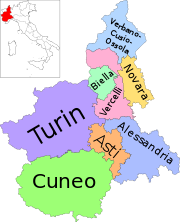Piedmont wine
This articlepossibly containsoriginal research.(May 2022) |

Piedmont wineis the range ofItalian winesmade in the region ofPiedmont,in the northwestern corner ofItaly. The best-known wines from the region includeBaroloandBarbaresco.They are made from theNebbiologrape. These wines are ideal for storage and a well-aged Barolo for instance may leave a feeling of drinking velvet because the tannins are polished and integrated more and more into the wine. As the wine matures the colour becomes more brownish and rust-red.
Other popular grapes used forred wineproduction areBarberaandDolcetto.Wine made with the Barbera grape is often fruity, with high acidity. It can be delicate with less tannin than wine made from the Nebbiolo grape. Dolcetto on the other side, is not, as the name indicates, sweet. Dolcetto means "little sweet one" (dolceis theItalianword for "sweet" ). The grape gives fresh and dry red wines with some tannin. The wines made with the Dolcetto grape are typically consumed relatively young.
Thesparkling wineAsti spumanteis made from theMoscatogrape. The majority of the area's winemaking take places in the provinces ofCuneo,AstiandAlessandria.TheBrachettois another variety used for making sweet and sparkling red wines.
WhileTurinis the capital of the Piedmont,AlbaandAstiare at the heart of the region's wine industry. The winemaking industry of the Piedmont played a significant role in the early stages of theRisorgimentowith some of the era's most prominent figures – such asCamillo Benso, conte di CavourandGiuseppe Garibaldi– owning vineyards in Piedmont region and making significant contributions to the development of Piedmontese wines. The excessively hightariffsimposed by theAustrian Empireon the export of Piedmontese wines to Austrian controlled areas of northern Italy was one of the underlying sparks to the revolutions of 1848–1849.
History
[edit]This sectionneeds additional citations forverification.(May 2022) |
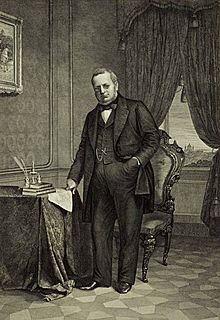
As in most ofItaly,native vines are abundant in the land that theAncient GreekscalledOenotrua(meaning "land of vines" ) and was subsequently cultivated by theRomans.With its close proximity, France has been a significant viticultural influence on the region, particularlyBurgundy,which is evident today in thevarietalstyles of most Piedmontese wines with very little blending. One of the earliest mention of Piedmontese wines occurred in the 14th century when the Italian agricultural writerPietro de Crescentiuswrote hisLiber Ruralium Commodorum.He noted the efforts of the Piedmontese to make "Greek style"sweet winesby twisting the stems of the grapes clusters and letting them hang longer on the vine to dry out. He also noted the changes withtrellisingin the region with more vines being staked close to the grounds rather than cultivated high among trees in the manner more common to Italian viticulture at the time. In the 17th century, the courtjewellerofCharles Emmanuel I, Duke of Savoyearned broad renown for his pale redChiarettomade entirely from the Nebbiolo grape.[1]
During theRisorgimento(Italian unification) of the 19th century, many Piemontese winemakers and land owners played a pivotal role. The famous Italian patriotGiuseppe Garibaldiwas a winemaker who in the 1850s introduced the use of theBordeaux mixtureto control the spread ofoidiumthat was starting to ravage the area's vineyards.Camillo Benso, conte di Cavourwas a wealthy vineyard owner who went abroad to study advanceviticultureprior to founding the political newspaperIl Risorgimento.He was highly influential in the adoption of many French viticultural techniques among the Piemontese vineyards.[1]

One of the early sparks of the Italianrevolts against Austriawas the act of the Austrian government to double thetariffsof Piemontese wines into the Austrian control lands ofLombardy,Emiliaand theVeneto.This had a crippling effect on the Piemontese wine industry, essentially cutting them off from their main export market. In 1846, KingCharles Albert of Sardiniaspoke to the Piedmontese winegrowers at the meeting of the Agricultural Congress atCasale Monferratowhere he assailed the Austrian oppression. By 1848, Piedmont was at war with Austria in one of the early events that eventually led to the unification of the Italian peninsula under the rule of Charles Albert's sonVictor Emmanuel.[1]
Climate and geography
[edit]The Piedmont region is located in the foothills of theAlpsforming its border withFranceandSwitzerland.To the northwest is theValle d'Aosta,to the east is the province ofLombardywith theLiguriaregion forming its southern border along theApennines.In addition to the vast mountainous terrain, thePo Valleyconsumes a large area of available land-leaving only 30% of the region suitable for vineyard plantings. The valley and the mountains do contribute to the area's notedfogcover which aides in the ripening of the Nebbiolo ("Nebieu") grape (which gets its name from the Piedmontese wordnebiameaning "fog" ).[2]
Although the winemaking regions of the Piedmont andBordeauxare very close inlatitude,only the summertime temperatures are similar: the Piedmont wine region has a colder,continental winter climate,and significantly lower rainfall due to therain shadoweffect of the Alps.[3][4]Vineyards are typically planted on hillsidesaltitudesbetween 490–1150 ft (150-400 metre). The warmer south facing slopes are mainly used for Nebbiolo orBarberawhile the cooler sites are planted withDolcettoorMoscato.[5]
Regions
[edit]

The majority of the region's winemaking (about 90%) takes place in the southern part of Piedmont around the towns ofAlba(inCuneo),AstiandAlessandria.[2] The Piemonte wine region is divided into five broad zones.[5]
- Canavese– includes the areas aroundTurinsuch asCaremaandCaluso
- Colline Novaresi– in the province ofNovara
- Coste della Sesia– includes the area aroundVercelli
- Langhe– includes the hill country around the city of Alba and theRoero.
- Monferrato– includes the areas around Asti and Alessandria
DOCs
[edit]The Piedmont region is home to 41denominazione di origine controllata(DOC) and 19denominazione di origine controllata e garantita(DOCG).[6][7]
The 19DOCG winesin Piedmont are:
- Alta Langa
- Asti
- Barbaresco
- Barbera d'Asti
- Barbera del Monferrato Superiore
- Barolo
- Brachetto d'Acqui,also called Acqui
- Ruchè di Castagnole Monferrato
- Canelli
- Cortese di Gavi,also simply called Gavi
- Dolcetto di Dogliani Superiore,also simply called Dogliani
- Dolcetto di Ovada Superiore,also simply called Ovada
- Dolcetto di Diano d'Alba,also simply called Diano d'Alba
- Erbaluce di Caluso,also simply called Caluso
- Gattinara
- Ghemme
- Nizza
- Roero,and Roero Arneis
- Terre Alfieri
Grapes and wines
[edit]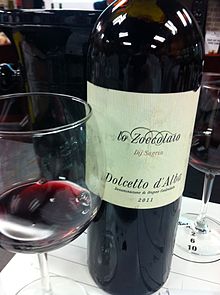
Barbera is the most widely planted grape in the region, but Nebbiolo and Dolcetto account for a significant portion of the area's red wine production as well. With white wines, Moscato is the most prominent with its sparkling andfrizzantestyle wines. Other notable white wines include styles made from theCortesegrape inGavias well as blends of Cortese withArneisandFavoritafromColli TortonesiandAlto Monferrato.Since the 1980s there has been growing numbers of experimental plantings with the international varieties ofCabernet Sauvignon,Chardonnay,Merlot,Pinot noir,Sauvignon blancandSyrah.[5]Other local or indigenous grapes includeBaratuciat,Bonarda,Croatina,Erbaluce,Freisa,Gamba di Pernice,Grignolino,Grisa nera,Malvasia nera,Pelaverga,Plassa,Rossese bianco,Timorasso,Uvalino,Uva RaraandVespolina.[2][8][9]
The Piedmont produces more DOCG wines by volume than any other Italian wine region with nearly 84% of all the areas wine production falling under a DOCG designation. The area has noindicazione geografica tipica(IGT) classification, in contrast toTuscanywhere IGT wines orSuper Tuscansmake up a significant portion of that region's wine production.[2]
Somevarietalstyle wines are made in the Piedmont region with the name of the grape and town both appearing on the label. Some DOC examples includeBarbera d'Alba,Barbera d'Asti,andDolcetto di Doglianimade entirely from the Barbera and Dolcetto grape respectively.[10]
Barolo
[edit]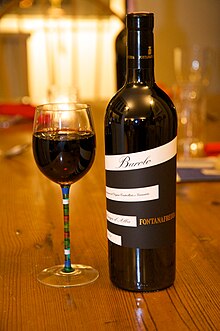
In 1980, the wines of the Barolo region became one of the first Italian wines to receive DOCG status. Produced to the southwest of the town of Alba in the hills of the Langhe, Barolo is a big,tannicexpression of the Nebbiolo grape. The soil of this area is a composition ofclayandmarlwhich helps to lessen the naturally high acidity of Nebbiolo. TheTanaro riverflows through the heart of Barolo country and serves as a tempering influence on the region's summertime heat till harvest time in late October/mid November. A small wine region, extending over 7 miles in length and 5 miles at its widest point, Barolo produces about 500,000casesof wine annually. Nearly 87% of the zone productions comes from vineyards in five communities:[11]Barolo,Castiglione Falletto,La Morra,Monforte d'Alba,andSerralunga d'Alba. Wines from the Central Valley of La Morra and Barolo tend to be very perfumed and velvety with less tannins than other Barolos. The soil of the Central Valley itself is more clay based with increased levels ofmagnesium oxideandmanganese.The wines from the Serralunga Valley are more fullbodiedandtannicand require aging of 12–15 years before they hit their peak.[citation needed]The soil of the Serralunga is heavy insand,iron,limestone,phosphorusandpotassium.[11]
Barbaresco
[edit]Being produced from the same grape as Barolo and less than 10 miles apart, there are a lot of similarities that Barbaresco has with it neighboring wines but the slightmaritime influenceof the Tanaro river helps fashion distinctly different wines. Generally less tannic, Barbaresco tend to be more elegant and approachable in their youth. The Barbaresco DOCG regulation stipulates wines with minimumalcohol contentof 12.5% and 2 years minimum aging in the winery for standard labels and 4 years minimum forriservaswines. Being an even smaller zone than Barolo, producers in the region produce a little more than 200,000 cases annually. The majority of Barbaresco production takes place in 3 communities:[12]Barbaresco,TreisoandNeive.The soils in the Barbaresco zone are more uniform across the region which tends to produce a more consistent profile with the wines than what can be achieved across the widely different areas of Barolo.[12]
Moscato d'Asti
[edit]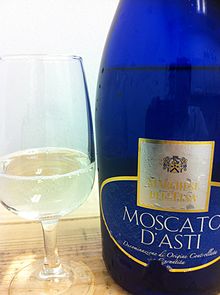
The white wines made from theMoscato Bianco(also known asMuscat Blanc à Petits Grains) are most noted for their frizzante and sparklingspumantestyles but some still wines are produced as well. Located northeast of Alba, the wines from the Asti region are known for their delicate light bodies, low alcohol content and slightly sweet nature.[13]Like many sparkling wines, Asti are notvintagedated even though a majority of the grapes might all come from the same vintage year. The wines are typically at their peak between 1 and 2 years from their release.[14]
Other wines
[edit]
The Barbera grape is the most widely planted variety in all of the Piedmont and makes a juicy, muscular red wine that is not as tannic as Barolo and Barbaresco. It is grown in nearly every major wine making region of the Piedmont but seems to do best in the southern part of the province of Asti in theNizzaDOCG zone. Some producers are experimenting with blending Barbera with Nebbiolo to combine the former's fruitiness with the later's structure. The light fruitiness of wines from the Dolcetto grape has caused some wine writers to describe it as the Italian version ofBeaujolais.The wines have a sense of spiciness to them with little acid and tannins. They are able to be drunk relatively young and tend to be the every day drinking wines of the Piedmontese.[15]
Up until the 1980s, when the wines of theFriuli-Venezia Giuliabegan to receive notice, the white wines of the Gavi region were touted as the best expression of dry Italian wine. Made primarily from the Cortese grape, these wines are noted for their dry, crisp acidity withcitrusandmineralnotes. The white wines made from theArneisgrape tend to be dry, vibrant and full body with notes ofpearsandapricots.Produced in the hills of the Roero to the northwest of Alba, the name Arneis means "rascal" in Piedmontese.[15]
See also
[edit]References
[edit]- ^abcH. JohnsonVintage: The Story of Winepg 412-423 Simon and Schuster 1989.ISBN0-671-68702-6.
- ^abcdM. Ewing-Mulligan & E. McCarthyItalian Wines for Dummiespg 38-41 Hungry Minds 2001.ISBN0-7645-5355-0.
- ^San Damiano d'Asti climatehttp://www.weatherbase.com/weather/weather.php3?s=161161&refer=&units=metric
- ^Bordeaux climatehttp://www.weatherbase.com/weather/weather.php3?s=1570&refer=&units=metric
- ^abcJ. Robinson (ed)"The Oxford Companion to Wine"Third Edition pg 525-526 Oxford University Press 2006.ISBN0-19-860990-6.
- ^Denominazione di Origine Controllata e Garantita#Elenco di vini DOCG
- ^"Vini a Denominazione di origine, DOCG e DOC".Regione Piemonte(in Italian).Retrieved2024-03-12.
- ^J. RobinsonJancis Robinson's Guide to Wine Grapespg 185 Oxford University Press 1996.ISBN0198600984.
- ^J. Robinson, J. Harding and J. VouillamozWine Grapes - A complete guide to 1,368 vine varieties, including their origins and flavourspgs 82, 910-911, 1106 Allen Lane 2012.ISBN978-1-846-14446-2.
- ^M. Ewing-Mulligan & E. McCarthyItalian Wines for Dummiespg 52 Hungry Minds 2001.ISBN0-7645-5355-0.
- ^abM. Ewing-Mulligan & E. McCarthyItalian Wines for Dummiespg 42-46 Hungry Minds 2001.ISBN0-7645-5355-0.
- ^abM. Ewing-Mulligan & E. McCarthyItalian Wines for Dummiespg 47-51 Hungry Minds 2001.ISBN0-7645-5355-0.
- ^K. MacNeilThe Wine Biblepg 327 Workman Publishing 2001.ISBN1-56305-434-5.
- ^M. Ewing-Mulligan & E. McCarthyItalian Wines for Dummiespg 62 Hungry Minds 2001.ISBN0-7645-5355-0.
- ^abK. MacNeilThe Wine Biblepg 331-333 Workman Publishing 2001.ISBN1-56305-434-5.

